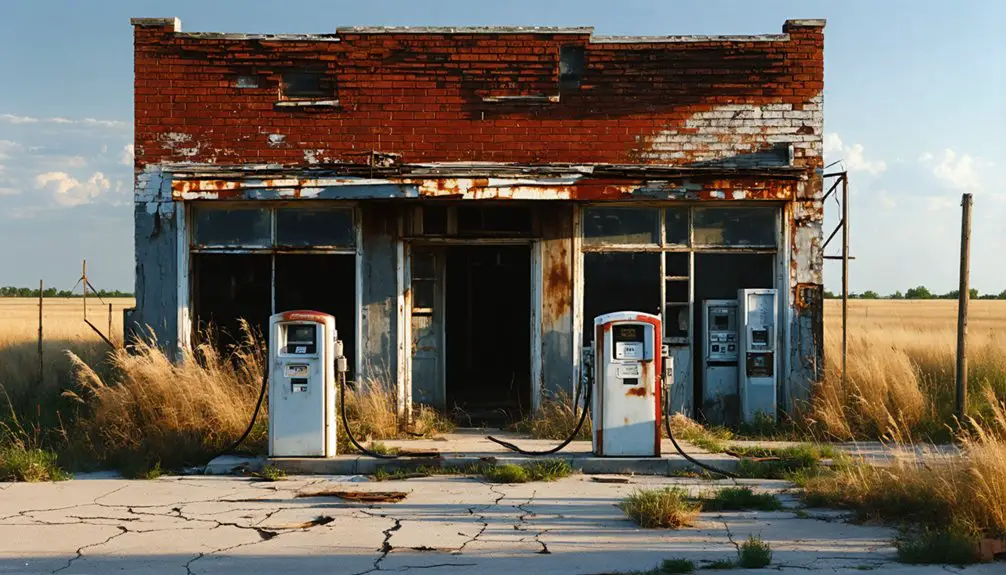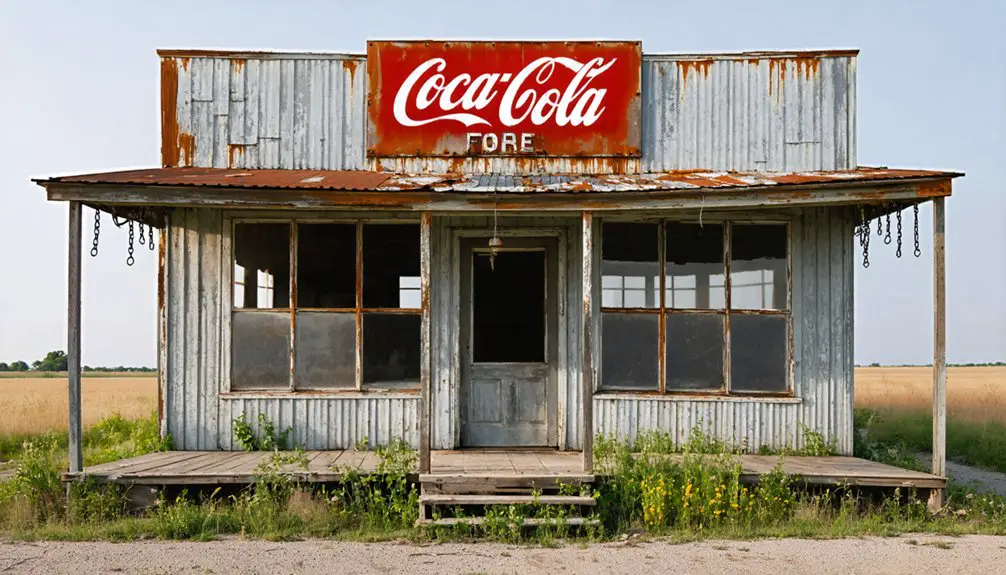You’ll discover Foraker in Oklahoma’s Osage County, where a thriving railroad stop became a bustling oil boomtown in the 1920s. After the discovery of the Burbank oil field in 1920, the population surged to 2,000 as the town shipped 122,000 barrels of oil per day. Today, fewer than 20 residents remain among the weathered buildings and empty lots along the old railway bed. Foraker’s story of boom and bust captures the essence of Oklahoma’s frontier spirit.
Key Takeaways
- Foraker declined from a bustling oil boom town of 2,000 residents in the 1920s to fewer than 20 people today.
- Founded in 1905 along the Midland Valley Railroad, the town flourished during the 1920s Burbank oil field discovery.
- The town earned $169,000 in oil-field supplies during 1922’s peak but emptied after the Great Depression and industry decline.
- Empty buildings, deteriorating structures, and abandoned storefronts now line the silent railway bed where commerce once thrived.
- Located near the Tallgrass Prairie Preserve, Foraker attracts ghost town enthusiasts and offers heritage tourism potential.
A Railroad Town Takes Root
When the U.S. Department of Interior platted a 160-acre tract along the Midland Valley Railroad in 1905, they’d set the stage for Foraker’s birth amid Oklahoma’s rolling plains and tallgrass prairie.
You’ll find it interesting that the post office actually preceded the town’s official establishment, opening its doors on February 13, 1903.
The railway’s significance can’t be overstated – as Foraker’s primary early transportation link, it transformed this patch of Osage County into a bustling community.
By 1909, you’d have found 500 residents thriving there, with ranching and farming driving the economy. The town shipped over 15,000 head of cattle during one remarkable six-month period.
The town’s strategic position became even more crucial when the Osage Railway was added, connecting Foraker to emerging oil towns and cementing its role as a essential regional transportation hub.
Early Days of Prairie Prosperity
As rail lines brought settlers and commerce to Foraker, the town’s agricultural foundation took root in the fertile Osage County soil. You’d find farmers cultivating vast fields of corn, wheat, and alfalfa, while ranchers shipped an impressive 15,000 cattle in just six months. These agricultural practices established Foraker’s early economic backbone. Located in one of several Osage Counties across America, the region’s rich soil supported extensive farming operations.
The town’s community organization quickly evolved to match its rural prosperity. You’d see concrete sidewalks lining the business district, where two banks served the growing population of 415 residents.
Three newspapers kept citizens informed, while multiple stores, lumberyards, and grain elevators supported daily commerce. The town’s investment in a $20,000 school building and three churches demonstrated its commitment to civic development, all before oil would transform Foraker’s destiny. The town earned its nickname as the Queen of the Osage during the prosperous oil boom of the 1920s.
The Black Gold Rush Transforms Foraker
The 1920 discovery of the Burbank oil field near Foraker sparked a dramatic transformation that would redefine the town’s identity.
You’d have witnessed the population surge to 394 as oil fever gripped the region, bringing unprecedented economic renewal to the prairie community.
Much like the treasure coach robberies that plagued the Black Hills gold rush, the newfound wealth from oil attracted its share of criminal elements to Foraker.
Like the mass migration to California’s goldfields in 1848, people from diverse backgrounds flocked to Foraker seeking their fortunes in oil.
Peak Years of Oil and Commerce
You’ll find Foraker’s peak prosperity directly tied to the Burbank field’s incredible output of 122,000 barrels per day in 1923, when over 1,000 wells dotted the landscape.
The oil boom’s wealth quickly transformed the town’s business district, with supply stores, services, and commerce expanding rapidly to support the surging oil workforce and their families. Just like the historic Nellie Johnstone Number One well that launched Oklahoma’s oil industry, Foraker’s wells helped drive the region’s petroleum development.
Rail connections became essential lifelines as they transported both oil products and commercial goods, solidifying Foraker’s position as a bustling hub during Oklahoma’s golden age of oil production. This era of prosperity aligned with Oklahoma’s status as top oil producer in the United States, alternating with California for this position between 1907 and 1930.
Oil Wells Bring Prosperity
During Foraker’s most prosperous era, which began in 1920 with the discovery of the Burbank oil field, this small Oklahoma town rapidly transformed into a bustling petroleum hub.
You’d have witnessed the town’s explosive growth as its population swelled from fewer than 25 residents to 394 by 1920. The oil wealth poured in, with local businesses earning $169,000 in just the first half of 1922 from lumber and oil-field supplies alone. The Osage headright beneficiaries received substantial royalties from the area’s petroleum production. In 1904, the completion of a major pipeline to Standard Oil’s refinery helped establish the region’s commercial viability.
As the “Queen of the Osage,” Foraker thrived on its strategic location along the Midland Valley Railroad.
You’d have seen 94-96 productive wells dotting the landscape, targeting the rich Bartlesville Sandstone formation. The community growth extended beyond oil, as the railroad enabled both petroleum and livestock commerce to flourish simultaneously.
Railway Transportation Expands Trade
Since establishing Foraker along its line in 1905, the Midland Valley Railroad transformed this once-sparse settlement into an indispensable transportation hub.
You’d witness railway economics in action as the Osage Railway extended to Shidler and Lyman in the 1920s, creating crucial trade networks for the booming oil industry.
The impact was dramatic – freight and passenger service tripled within a year. You’d see 94 productive oil wells by 1922, with local businesses reporting $169,000 in sales from lumber and oil-field supplies.
The rail system didn’t just serve oil interests – it moved an impressive 15,000 cattle in just six months. As trade flourished, Foraker’s population swelled from 500 to 2,000, while Osage County grew from 15,332 to 47,334 residents by 1930.
Booming Business District Growth
While many Oklahoma towns experienced rapid growth during the oil boom, Foraker’s business district expansion stood out for its remarkable stability and diverse economic base. You’d have found a thriving commercial hub handling over $169,000 in business revenue by 1922, driven by 94 productive oil wells in the region.
The town’s business expansion reflected careful local investments rather than chaotic development. You would’ve seen new commercial buildings catering to both oil and ranching needs, with lumber yards and petroleum supply stores anchoring the district. The bustling activity attracted investors who participated in Million Dollar Elm auctions nearby in Pawhuska.
The construction of a $6,000 gymnasium in 1924 demonstrated the community’s commitment to lasting infrastructure. Unlike typical boomtowns plagued by lawlessness, Foraker maintained an orderly atmosphere while serving as a vital distribution center for oil-field equipment throughout Osage County.
When the Boom Went Bust
After riding high on the combined success of agriculture and oil in the early 1920s, Foraker’s fortunes took a dramatic downturn as the Great Depression hit and the Osage County oil boom began to fade.
You’d have seen the town’s population plummet from its peak of 2,000 as the oil industry’s decline accelerated through the 1930s. Despite the community’s resilience, the economic adaptation proved challenging when nearby refineries closed after World War II.
The once-thriving town withered away as oil fortunes dried up, leaving empty streets where thousands had bustled through the boom years.
The consolidation of farms and ranches further eroded Foraker’s agricultural base. Though the town had been spared the worst of the boomtown lawlessness since the oil fields weren’t directly adjacent, it couldn’t escape the inevitable economic collapse.
The once-bustling streets that had generated $169,000 in business during 1922 gradually emptied as residents sought opportunities elsewhere.
Present-Day Ghost Town Legacy

Today you’ll find only scattered remnants of Foraker’s oil boom heyday, with the old Methodist church and a few homes standing among broken sidewalks and ghostly concrete foundations that lead nowhere.
The town’s dwindling population of fewer than 20 residents commutes elsewhere for work, leaving behind empty lots where bustling businesses once stood along the silent railway bed.
While ghost town enthusiasts occasionally visit to photograph the ruins, Foraker’s proximity to the Tallgrass Prairie Preserve offers untapped potential for heritage tourism that could tell the story of Oklahoma’s oil industry and rural decline.
Abandoned Buildings Today
Throughout Foraker’s silent streets, abandoned buildings stand as deteriorating remnants of Oklahoma’s frontier past.
You’ll find early 20th-century structures now showing severe urban decay – from collapsed roofs to broken windows and crumbling walls. These ghostly remains include old homes, storefronts, and industrial buildings that once served the bustling community.
While these structures still showcase glimpses of historic architecture and craftsmanship, they’ve become significant safety hazards.
You’ll need to be cautious, as unstable floors, exposed nails, and falling debris make exploration dangerous. Local authorities have marked many buildings as dilapidated, though preservation groups work to document these pieces of Oklahoma heritage.
Despite their deteriorated state, these abandoned structures continue telling stories of Foraker’s pioneering spirit through their weathered facades and fading signs.
Rural Tourism Potential
Despite its diminished population, Foraker holds significant potential as a heritage tourism destination within Oklahoma’s rich landscape of ghost towns.
You’ll discover a compelling narrative spanning the 1920s oil boom, railroad heritage, and deep connections to Osage Nation history. The town’s cultural significance is amplified by its proximity to the Tallgrass Prairie Preserve, creating opportunities for combined eco-tourism and historical exploration.
You can trace Foraker’s transformation from a bustling oil town of nearly 400 residents to its current state, while exploring its place among Osage County’s network of ghost towns.
The region’s renewed interest, sparked by “Killers of the Flower Moon,” positions Foraker perfectly for heritage tourism development through interpretive signage, guided tours, and digital storytelling experiences.
Preserving Foraker’s Historical Memory
While Foraker’s physical structures have largely vanished from Oklahoma’s landscape, dedicated efforts to preserve its historical memory continue through multiple channels.
You’ll find historical preservation efforts led by the Oklahoma Historical Society and Osage County heritage groups, who maintain extensive archives of photographs, census data, and business records from Foraker’s heyday.
Community engagement thrives through oral history collections, featuring stories from former residents and their descendants about life during the town’s peak years.
Personal stories of Foraker’s vibrant past live on through recorded memories of those who once called it home.
The prairie cemetery east of town serves as a tangible link to the past, while interpretive signage projects and heritage trail markers are being proposed to help you understand Foraker’s significance.
Local ranchers work to balance land use with preservation, protecting both the historical sites and surrounding tallgrass prairie ecosystem.
Frequently Asked Questions
Are There Any Remaining Original Buildings Still Standing in Foraker Today?
You’ll find few historic preservation efforts, with only the Methodist Church and scattered homes still standing. Most structures of architectural significance were lost to fire, demolition, or decay over time.
What Role Did Native American Communities Play in Foraker’s Development?
On 1.5 million acres of purchased Cherokee land, Osage tribal influence shaped Foraker’s growth through oil rights and cultural exchange, with you’ll find their presence reflected in local mineral development patterns.
Was Foraker Ever Affected by Significant Natural Disasters or Extreme Weather?
You won’t find evidence of major natural disasters striking Foraker. Despite Oklahoma’s tornado history and regional flood impacts, historical records don’t show any significant weather events affecting the town’s development.
Did Any Famous Outlaws or Lawmen Have Connections to Foraker?
You won’t find any documented outlaw associations or lawman encounters in this town’s history. Historical records show it remained a peaceful agricultural and oil supply center without notable criminal connections.
Were There Any Notable Conflicts Between Ranchers and Oil Companies?
You won’t find major ranching disputes during Foraker’s oil boom – mineral rights retention by property owners and the oil field’s distance from town helped maintain peaceful coexistence between ranchers and oil companies.
References
- https://www.wikiwand.com/en/articles/Foraker
- https://kids.kiddle.co/Foraker
- https://www.okhistory.org/publications/enc/entry?entry=FO016
- https://www.youtube.com/watch?v=pRIJ7Iq6-6g
- https://en.wikipedia.org/wiki/List_of_ghost_towns_in_Oklahoma
- https://www.youtube.com/watch?v=094qHoGKCZY
- https://www.okhistory.org/publications/enc/entry?entry=SH033
- https://www.fitzvideo.com/skysurfing2/2013/10/15/cowboy-country-a-flight-to-foraker-oklahoma-by-brian-fitzgerald/
- https://en.wikipedia.org/wiki/Osage_County
- https://explorer.aapg.org/story/articleid/66713/the-osage-nations-oil-and-gas-great-wealth-and-sheer-terror



